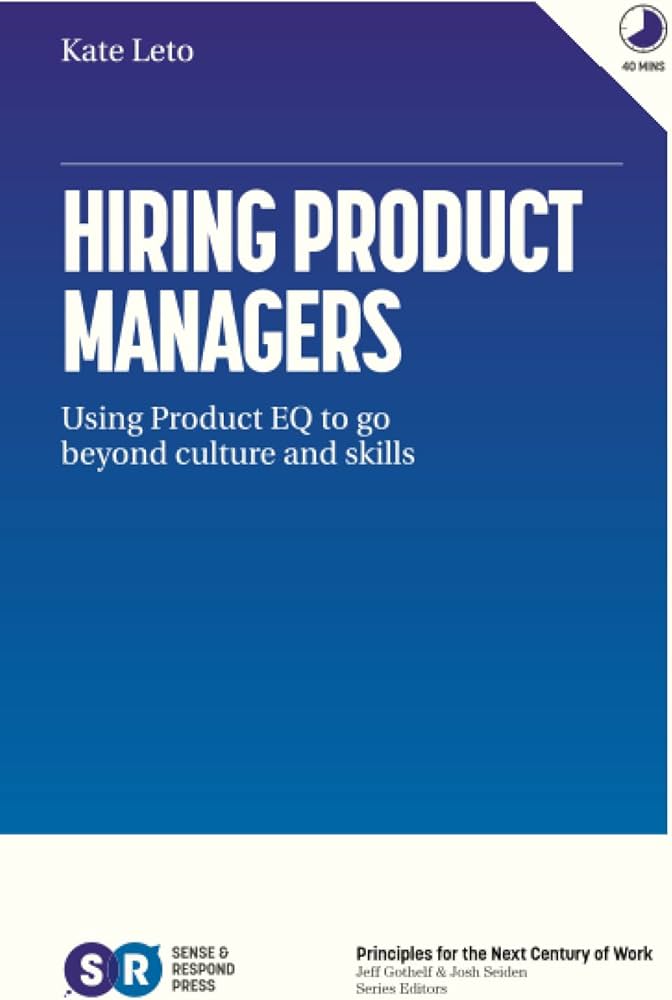
Review
I love a short book, but this one didn’t have too much to offer. The key insight is that human skills are just as important as technical skills in product management. I fully agreed with with the stance on looking for cultural contributions and not cultural fit, but I don’t think that’s new thinking. I didn’t ‘applying continuous learning’ to your hiring process to be that enlightening either.
Key Takeaways
The 20% that gave me 80% of the value:
- It takes a special set of skills to continually experiment in times of stress and pressure. It requires a unique type of leadership and culture to empower teams to do just that
- Product managers need both Technical Skills and Human Skills, achieving a balance of both is important.
- Technical skills are the techniques and tools that product people use to solve the customer problem, deliver and support a product. Technical skills represent what a product person does (during ideation, creation, delivery and iteration).
- If you prioritize technical skills too much, you’ll end up with a lack of human skills in the practice.
- A job description provides great insight into how a company really thinks about a position. Design it well, and it will help build a great team.
- Emotional Intelligence: ability to recognize, understand and manage your own emotions and ability o recognize, understand and influence the emotions of others
- Dimensions of EQ as defined by Goleman:
| Self-awareness | ability to know what we’re feeling and why we’re feeling it. helps intuition and decision making |
| Self-management | ability to handle distressing emotions ability to connect with positive emotions |
| Social awareness | ability to handle relationships and awareness of others feelings, needs and concerns |
| Relationship management | making relationships positive and beneficial for both parties |
- Consider a cross-functional role creation workshop. Build a role canvas as a group:
| Purpose | Why does the role exist? |
| Accountabilities | What are the goals or outcomes the tole will be working toward? – list the known goals or outcomes |
| Human Skills | E.g: Leadership, conflict resolution, influence, adaptability |
| Technical Skills | E.g: Roadmaps, design sprints, product vision statement, JTBD, OKRs |
- Translate the canvas into a job description
- In interviews, behavior-based questions are the way to go. They help you understand the behaviors that led to people’s accomplishments. The intentions behind the behaviors, and consequences and impact of the behaviors on others.
- Ask behavior-based questions that relate to EQ
- Listen to what a candidate is saying and identify the intentions behind a behavior
- Brainstorm behavior based questions that will help you understand the candidates intentions and thinking behind their behaviors
- Get back together as a group and iterate on your interview questions and structure
- The work you do to change the hiring process, will change the makeup of your teams, how you work, the products you produce and the culture you’re all apart of
- The chain reaction of hiring well: Individuals → Team → Organization
- Don’t hire for fit.Diversity is better for innovation:
- Inherent diversity: traits that you’re born with like gender, ethnicity and sexual orientation
- Acquired diversity: traits you gain from experiences, working in another county, creating products for customers not like you
- Don’t build a team of clones. You want your team to look like a puzzle not a stack. You want everyone to look different but fit together
- Look for culture contributions.
- Candidates need to fit your company values, and bring a cultural contribution.
- Add interview questions that help you check for value alignment…
- How to reflect on a candidate after an interview?
- Will they challenge the team’s current thinking and process?
- Does the candidate bring new energy to the table?
- Did you learn something new from the candidate?
- Remember to explain where your thinking is coming from. Was it something they said? Their body language?
- Constantly think about iterating on each stage of your hiring pipeline at any point in time
- Continually sense, respond and evolve to find the right person for the role
- Think of it as a cycle of continuous learning
- Have regular retro’s to speak to the team, review qualitative and quantitative insights and propose changes
- After you make a hire → reflect on the hire in a retro